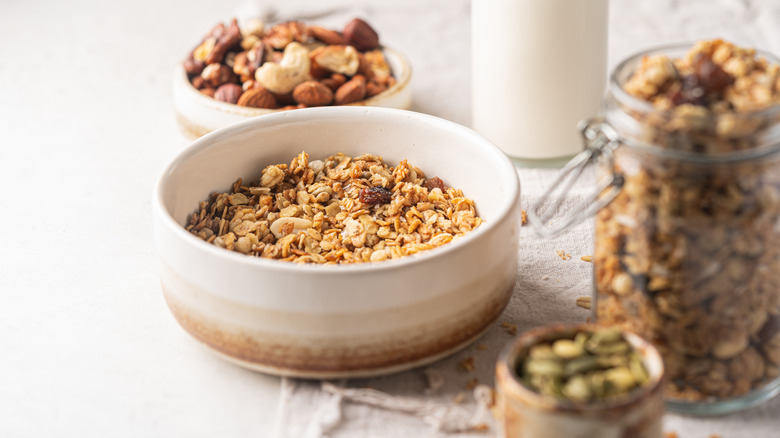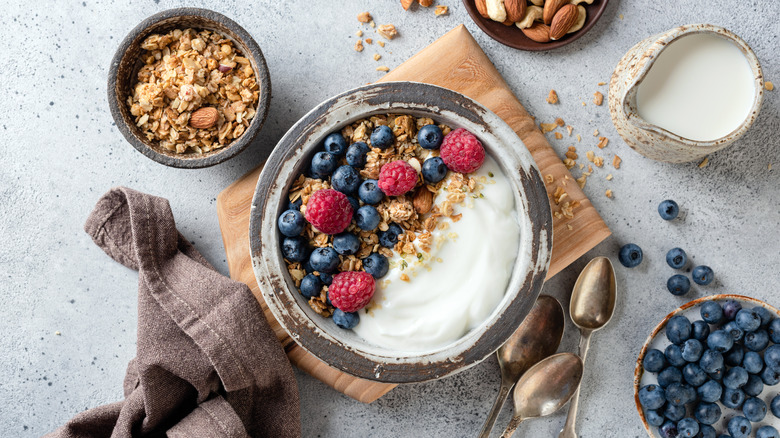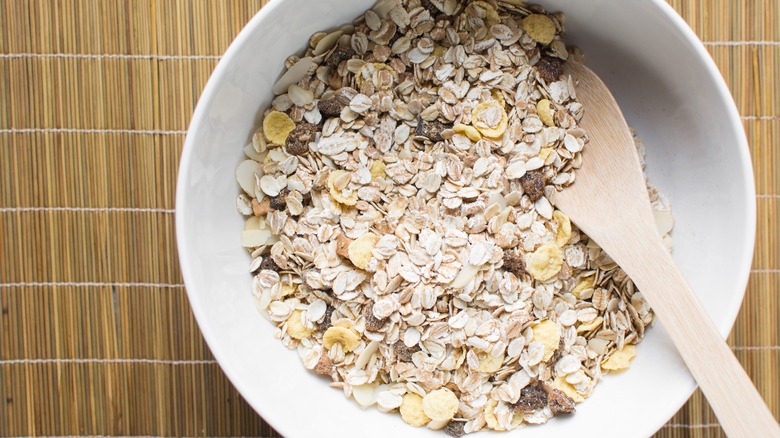The Difference Between Muesli And Granola
An internet search of the word "muesli" often prompts results for granola — which is not the same thing. So, what's the difference between these nutrient-dense, shelf-stable, oat-based snacks? Both granola and muesli can be made at home in bulk batches, and share a "food as medicine" connotation. They even share mostly identical ingredient lists. But, while the key distinctions between muesli and granola may be few, they are major.
Before unpacking the differences, it can be helpful to start with a foundational reminder of what these two varieties actually are. The chief ingredients in granola are rolled oats, crushed nuts, and honey. Granola is commonly served as a topping over yogurt or oatmeal, or snacked on straight out of the bag. Muesli (pronounced mews-li) is a mixture of fruit, nuts, and grains. It's often enjoyed with milk as a breakfast cereal (also notably lower in sugar and calories than many boxed breakfast cereals). Another popular serving style is to soak muesli in milk or yogurt in the fridge "overnight oats" style, or it can be incorporated into baked goods like muffins, cookies, or pancakes.
Muesli is chewy and savory, while granola is crunchy and sweet
Perhaps the most obvious difference between muesli and granola is their drastically different flavors. Granola tends to include sweeter mix-ins like chocolate, peanut butter, or vanilla for a sweet and salty, sometimes dessert-like taste. Granola's flexibility allows it to come in a wide variety of flavors like pumpkin spice, toasted coconut, vanilla, chocolate, cinnamon spice, blueberry banana, savory rosemary, and more, which line grocery store cereal aisles.
Conversely, muesli doesn't exactly come in different "flavors." The taste of muesli is savory and neutral, and more or less consistent, but it can include different ingredients, which influences the taste. Muesli is highly customizable and can also include other seed, nut, and fruit mix-ins like chia seeds, pepitas, sunflower seeds, hemp seeds, rice crisps, almond slivers, walnuts, pecans, hazelnuts, wheat germ, shredded coconut, dried apricots, dried cherries, dried figs, golden raisins, barley flakes, millet, dates, or apple chips. Different packaged brands offer different property muesli blends. But, in general, it doesn't share granola's sweetness or wide potential for variation.
Granola is baked and muesli is raw
To illustrate their chief difference, it can be helpful to think of muesli as essentially the midway point between granola and oatmeal. Muesli is enjoyed raw, while granola is baked. In muesli, the grains, seeds, and nuts are commonly toasted in the oven until fragrant, but that's the extent of any preparation. This is why muesli has a chewy, toothy consistency rather than crunchy, toasty granola. This necessitates a neutral cooking oil for the baking process in granola, an ingredient which muesli does not have. Granola also contains sweeteners or binding agents like brown sugar, honey, or maple syrup. In addition to taste, this means that, texturally, muesli is loose while granola is condensed into stuck-together clusters.
One is not necessarily healthier than the other. They're comparable in fiber and protein values, but ½ cup of muesli on average contains 151 calories and 11 grams of sugar while ½ cup of granola on average packs 212 calories and 15.5 grams of sugar. Although, it's also worth noting that the average serving size is different for muesli and granola. Muesli is often enjoyed as a porridge or breakfast cereal, clocking in around ¾ cup per serving size, while crunchy granola is often enjoyed as a snack or topping, with a smaller serving size around ¼ cup to ½ cup.


